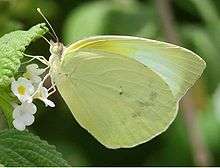Kricogonia lyside
Kricogonia lyside, the lyside sulphur or guayacan sulphur,[2] is a North American, Caribbean, and South American butterfly in the family Pieridae.
| Kricogonia lyside | |
|---|---|
 | |
| Scientific classification | |
| Kingdom: | |
| Phylum: | |
| Class: | |
| Order: | |
| Family: | |
| Genus: | |
| Species: | K. lyside |
| Binomial name | |
| Kricogonia lyside | |
In seasons with heavy monsoons, this butterfly is seen in massive migrations which are frequent in Texas but more rare in the southwest. It is also an occasional resident in southern Florida.
Description
The lyside sulphur is variable. The upperside of the wings is pale yellow, usually with a black bar on the leading edge of the hindwing and a bright yellow patch near the base of the forewing. Some individuals also have black borders along the costa and apex of the forewing. The underside of the wings varies from a greenish color to bright yellow to almost white.[3] Greener individuals have a whitish vein in the center of the hindwing and a bright yellow forewing basal patch.[4] It has a wingspan of 3.8 to 6 cm (1.5 to 2.4 in).[5]
Similar species
Similar species in the lyside sulphur's range include Queen Alexandra's sulphur (Colias alexandra), the cloudless sulphur (Phoebis sennae), and the statira sulphur (Aphrissa statira).
Queen Alexandra's sulphur has more yellow on the underside of the forewing and has a whitish spot in the center of the hindwing.[6]
The cloudless sulphur is larger and is much more yellow.[6]
The statira sulphur has a more yellowish upper side and the underside of the wings is pale greenish to white with females having light pinkish markings.[3]
Habitat
The lyside sulphur may be found in open, subtropical scrub.[2]
Flight
This butterfly is seen almost all year in southern Texas[2] and is seen from early July to mid-November in Arizona.[6] In Florida there have been scattered sightings from July to October.[4]
Life cycle
The larva is highly variable. It ranges in color from grass green to blackish green. It may have markings or may be unmarked. Marked individuals usually have dorsal and spiracular silvery stripes. It is the only caterpillar to feed on plants in the family Zygophyllaceae.[7] Apparently they feed exclusively on the leaves of three Guaiacum species: G. sanctum and G. angustifolium in Central and North America and G. officinale in South America and the Caribbean.[3][5][8] The chrysalis is a bluish-green color.[2] The lyside sulphur can grow from egg to adult in as little as 13 days. It has three or more broods per year in southern Texas.[8]
References
| Wikispecies has information related to Kricogonia lyside |
- Godart, M. (1819). Encyclopédie méthodique. Histoire Naturelle. Volume 9. Paris: Chez Mme. veuve Agasse. doi:10.5962/bhl.title.7834., page 98
- Scott, James A. (1986). The Butterflies of North America. Stanford, CA: Stanford University Press. ISBN 978-0-8047-2013-7.
- Brock, Jim P.; Kenn Kaufman (2003). Butterflies of North America. New York, NY: Houghton Mifflin. ISBN 978-0-618-15312-1.
- Cech, Rick; Guy Tudor (2005). Butterflies of the East Coast. Princeton, NJ: Princeton University Press. ISBN 978-0-691-09055-9.
- "Lyside Sulphur Kricogonia lyside (Godart, 1819)". Butterflies and Moths of North America. Archived from the original on 2010-06-20. Retrieved 2010-09-07.
- Stewart, Bob; Priscilla Brodkin; Hank Brodkin (2001). Butterflies of Arizona. West Coast Lady Press. ISBN 978-0-9663072-1-4.
- Beccaloni, George W.; Ángel L. Viloria.; Stephen K. Hall.; Gaden S. Robinson (2008). Catalogue of the hostplants of the Neotropical butterflies. Catálogo de las plantas huésped de las mariposas neotropicales, Sociedad Entomológica Aragonesa (SEA)/ Red Iberoamericana de Biogeografía y Entomología Sistemática (RIBES)/ Ciencia y Tecnología para el Desarrollo (CYTED) / Natural History Museum, London (NHM) / Instituto Venezolano de Investigaciones Científicas, m3m: Monografías 3ercer Milenio, volumen 8 , Zaragoza, 536 pp., 1 fig. 3 tabls. ISBN 978-84-935872-2-2
- Allen, Thomas J.; Jim P. Brock; Jeffrey Glassberg (2005). Caterpillars in the Field and Garden. New York, NY: Oxford University Press. ISBN 978-0-19-514987-6.
| Wikimedia Commons has media related to Kricogonia lyside. |